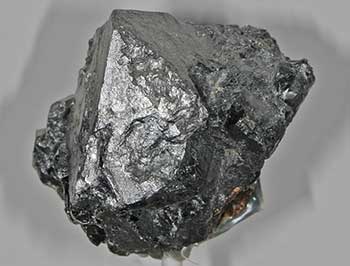 |
| Chromite - FeCr2O4. |
Chromium is a hard, bluish metallic element (Cr) with an atomic number of 24. In the mid-1700's, chemical analysis of a mineral from Siberia showed that it contained lead. This mineral, crocoite (PbCrO4, lead chromate), was known as "red lead" because of the beautiful orange-red color of its crystals. It also contained another, then-unknown material. This material was identified as chromium oxide (CrO3) by Louis-Nicholas Vauquelin. In 1797, he heated this oxide with charcoal to remove the oxygen (chemists call this reaction a reducing process) which left the metal chromium.
Shortly after Vauquelin's discovery, a German chemist name Tassaert discovered chromium in an ore that geologists now call chromite (FeCr2O4, ferrous chromic oxide). Chromite forms in an igneous environment.
The mineral chromite is the only commercial source of chromium. The largest U.S. chromium resource is in the geologic area known as the Stillwater Complex in Montana, but the chromium content is too low to be economically recoverable at this time. Chromium is not recovered from domestically mined ores. U.S. imports of chromium are mainly from, in descending order of import tonnage, South Africa, Kazakhstan, Zimbabwe, Turkey, and Russia. About 80% of world production of chromite comes from India, Kazakhstan, South Africa, and Turkey. South Africa produces one-half of this. Chromium is used in alloy steel, stainless steel, and superalloys; chemicals and leather processing; and other applications.
Name
The name chromium was derived from the Greek word chroma which means color, in reference to the fact that chromium is known to cause a number of colors in a variety of materials. For example, the green color of emerald is caused by the presence of very small amounts of chromium in the crystal.
Sources
The only ore of chromium is the mineral chromite. United States chromium consumption is equivalent to about 14% of all the chromite ore mined each year. In the western hemisphere, chromite ore is produced only in Brazil and Cuba; the United States, Mexico and Canada do not produce chromite. (The Stillwater Complex in Montana is the biggest chromium deposit in the United States, however it is not producing chromite ore at this time.) By comparison, about 80% of world production of chromite comes from India, Kazakhstan, Turkey and southern Africa. Southern Africa itself produces about half of this.
Geologists estimate that there are about 11 billion tons of chromium ore (chromite) in the world that could be mined. Most of these resources are found in southern Africa. This is enough chromium ore to meet world demand for hundreds of years into the future.
Uses
Chromium is alloyed (that is, mixed with) steel to make it corrosion resistant or harder. An example is its use in the production of stainless steel, a bright, shiny steel that is strong and resistant to oxidation (rust). Stainless steel production consumes most of the chromium produced annually. Chromium is also used to make heat-resisting steel. So-called "superalloys" use chromium and have strategic military applications.
Chromium also has some use in the manufacture of certain chemicals. For example, chromium-bearing chemicals are used in the process of tanning leather. Chromium compounds are also used in the textiles industries to produce a yellow color.
Substitutes and Alternative Sources
There is no good alternative for chromium in the manufacture of steel or chromium chemicals. Scrap metal that contains chromium can be recycled as an alternative source. The natural abundance of chromite in the Earth's crust makes alternative sources unnecessary at this time.